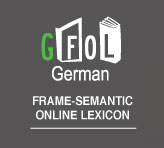Video Introduction and Overview
Start with the video for a comprehensive overview of the website and the various kinds of information it provides. This overview is in English and is appropriate for anyone wishing to learn more about the GFOL and how it works.
Click here to download a pdf of our quick start guide.
The German Frame-Semantic Online Lexicon consists of:
Frame Pages and Lexical Entries
Frame Pages
To access a Frame page, click on a frame in the “Choose Frame...” menu at the top of the page. The Frame page contains:
- the name of the frame (semantic domain),
- the frame description, which describes the frame in simple terms and discusses any relevant differences between German and English,
- a list of frame elements, or the types of participants which are necessary to understand the frame (often realized as nouns in sentences), and
- a list of German words and expressions, known as lexical units, each with their part of speech (e.g. noun, verb) and English gloss.
Lexical Entries
Click on the See All Information bubble of any of the German words/epressions on the Frame page to view that item's complete Lexical Entry. Each Lexical Entry contains the following kinds of information:
- Details of the lexical unit's meaning, including a simple translation of the German word and an indication of the word’s meaning in context (see for instance "putzen," "to brush," in the Grooming frame), and a brief description of important meaning and grammatical differences between German and English, if necessary (cf. "Freund," "friend," in the Personal Relationship frame),
- Examples of how the lexical unit is used in German, complete with English translations. In these sentences, the lexical unit that evokes the meaning of the frame is in bold, and frame elements are color-coded to show how they appear with relation to the target lexical unit and frame. As much as possible, translations are word for word, but sometimes it's necessary to rearrange words a little so that the English meaning is correct.
- Grammar Notes (if relevant) that describe aspects of the grammatical structures associated with the lexical unit and give a variety of examples,
- Sentence Templates that show the most basic way(s) in which frame elements combine with the lexical unit to build a sentence (or sometimes a phrase, depending on the part of speech of the lexical unit), and
- Alternate Forms of the lexical unit, just as you would find in a traditional dictionary -- for example, plural forms of nouns, 3rd person present, simple past and perfect forms of verbs, etc.
Abbreviations
| Abbreviation | German | English |
| adj. | Adjektiv | adjective |
| adv. | Adverb | adverb |
| akk. | Akkusativ | accusative case |
| dat. | Dativ | dative case |
| etw. | etwas | something |
| f. | feminin | feminine |
| gen. | Genitiv | genitive case |
| imp. | Imperfekt (Präteritum) | simple past tense (written past tense) |
| jmdm. | jemandem | someone (in dative case) |
| jmdn. | jemanden | someone (in accusative case) |
| lit. | --- | literally |
| m. | maskulin | masculine |
| n. | Nomen | noun |
| nom. | Nominativ | nominative case |
| part. | Partizip | participle |
| perf. | Perfekt | present perfect tense (conversational past tense) |
| pl. | plural | plural |
| pr. | Präsens | present tense |
| sing. | singular | singular |
| ugs. | umgangssprachlich | slang |
| usw. | und so weiter | et cetera (etc.) |
| v. | Verb | verb |
| zus. | zusammen | together |
Conventions for Examples
| Meaning | Example | |
| ( ) | Whatever is inside the parentheses is optional | Ich bade (mich). - I bathe (myself). |
| bold text | The target LU (the word you are learning about) is in bold | Example for the verb "baden" - Ich bade mich. |
